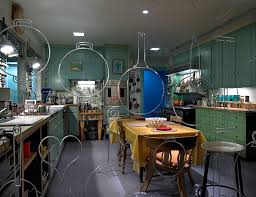By Professor Tiffany Banks On Tuesday, September 30th , students from my COMM 108: Foundations…
Our next seminar brought us to the Deep Time exhibit at the National Museum of Natural History (NMNH) which looks at climate change through the lens of history.
Scott Wing, Research Geologist and Curator of Paleobotany at NMNH led off the afternoon. His presentation, titled “What a long ago episode of global warming says about our future” focused on the Paleocene-Eocene Thermal Maximum period, or PETM which occurred some 56 million years ago. During this time global temperatures increased between 4-8 degrees C, resulting in a period of significant warming that lasted for about 200,000 years. There was an associated period of massive carbon release into the atmosphere that has been estimated to have lasted from 20,000 to 50,000 years. The result? A tropical, wet climate that extended far northward towards the arctic (yes, think palm trees in Alaska!). His presentation demonstrated how using the lessons of the PETM can help examine the climate changes we are experiencing today.
Siobhan Harris, Exhibition Developer and Specialist at the museum followed with a behind the scenes look at what is involved in developing an exhibit. Focused on the Deep Time exhibit, Fellows were led through the process of looking at the objects and stories provided by the exhibition curators and considering the actual physical space available in order to create an exhibit that engages, informs and perhaps challenges visitors. Deep Time was designed with the expectation that it will have a 20-30 year life, during which it will be visited upwards of 60 million times. Therefore, consideration had to be given to both the present and the future. What elements will need to be changed or updated over time? What elements will have longevity? Much work is focused on the audience. The exhibit needs to engage young children and their grandparents, teenagers and those on school trips, visitors from other countries and and those with a professional connection to the subject matter. Siobhan and her team combined their own professional experience with consultations with communication specialists and social scientists. They observed visitors at other exhibits in the museum to see what elements were most attention-grabbing. They considered the average amount of time someone spends on each display as they move through an exhibit. Her presentation added a level of depth to what goes into exhibition development that many had not thought about before.
Jennifer Collins, Office of Education, NMNH brought the afternoon full circle as she talked about the work she and others do to develop programs both in the museum and online for children, teens and adults. She shared some of the communication strategies used, the types and placement of interactive opportunities throughout the exhibit and the ways in which volunteers are empowered through in-person training and coaching. She shared a number of resources that have been developed and shared some hints of what is planned when the museum reopens. It was clear that much thought is being given to that reopening, with all three of our presenters eager for that event.





This Post Has 0 Comments